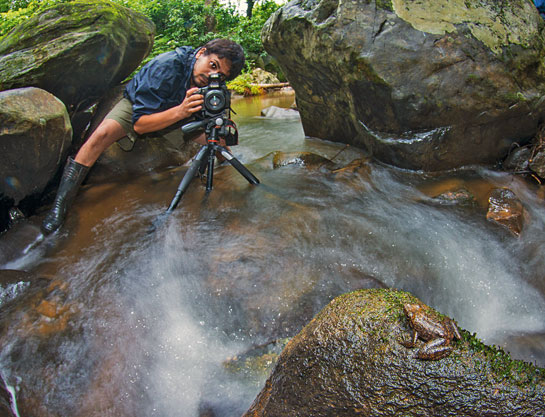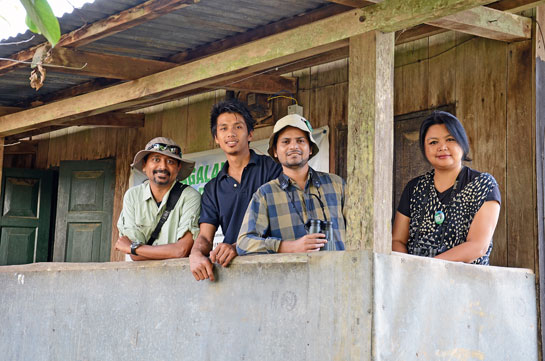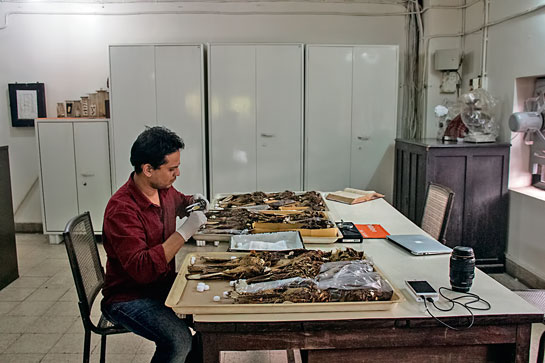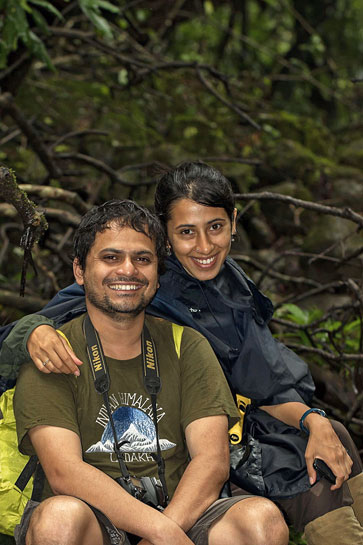Meet Shashank Dalvi: Naturalist, Conservationist, Scientist
First published in Sanctuary Asia,
Vol. 37
No. 12,
December 2017
This Sanctuary Wildlife Service Award 2017 winner's career path was set early in childhood. Between walks through Mumbai's Sanjay Gandhi National Park and explorations through virtually every biogeographic zone on the Indian subcontinent, this remarkable young man has described a new species of bird to science and personally seen and documented as many as 1,190 avian species in India. A long-time associate of author and birding expert, Bikram Grewal, he met him to share both purpose and vision with Sanctuary readers.
Shashank, you are only 34 years old, but your interest in wildlife and birds already spans over a decade. Tell us about your journey.
I remember being gifted a book on the mammals of India by my grandfather when I was just four. And read it again and again until I knew it by rote. When I was seven our teacher asked us to write on the animal we liked the most, and while most of my friends wrote on dogs and cats, I chose the Asian elephant. My love for birds was born when my grandmother brought home a caged bird. Curious about its identity, I looked in the book Common Birds (India - the Land and People) by Dr. Sálim Ali and Laeeq Futehally and discovered it was a Red-vented Bulbul. Not happy with seeing the bird in a cage, I began to spend virtually every holiday and any spare time I had exploring the Sanjay Gandhi National Park and other birding spots in Mumbai. On one such field trip, I met Dr. Anish Andheria who promised to take me with him every time he came, provided I stopped walking alone inside the national park. Between him and the inimitable Dr. Parvish Pandya, Vice Principal of Bhavans College, I was fortunate to be gifted the practical knowledge I needed to launch a life enriched by an understanding of natural history, ecology and conservation. through my high school and college years.
Was the Wildlife Conservation Society a key stepping stone?
It was indeed an important stepping stone. My association with the Society began in 2010 when I joined the Master's programme jointly offered by WCS India and NCBS. I received intensive scientific training, interacted with and learned from peers, wildlife biologists and conservationists across the world. Dr. Ajith Kumar, the Course Director, guided me through those years. And it was here that I met my wife, Vishnupriya. After my Masters, I joined WCS as a Research Associate and worked with them on a National Science Foundation (NSF)-funded project. This was a collaborative large-scale effort to study patterns of biodiversity across coffee, rubber and arecanut agroforests across 30,000 sq. km. of Karnataka's Western Ghats. During my stint there, I was supported by many individuals, particularly Dr. Krithi Karanth and Dr. Ullas Karanth.
A Mumbai boy, what is it about the Northeast that has you in its grip?
Northeast India was my dream destination since childhood. When I was given the opportunity to work on a biodiversity project at the Eaglenest Wildlife Sanctuary, I jumped at the chance. I said yes to Dr. Ramana Athreya without even speaking to family or anyone at my college (I was then an undergrad). That trip was the start of my love affair with the Northeast, one of the world's most incredible biodiversity hotspots. When bird activity was low, all I had to do was turn to amphibians, reptiles, butterflies or mammals. It was an incredible period in my life when I worked with different organisations and scientists in the remotest parts of Arunachal Pradesh, Nagaland, Mizoram, Meghalaya and Assam. The sheer diversity continues to amaze me and keeps me wanting to go back for more.
 Photo: Dhritiman Mukherjee
Photo: Dhritiman Mukherjee
What triggered ‘The Big Year' for you?
In my early birding days, I came across Kingbird Highway by Ken Kauffman. It was a story of his big year across the U.S. I knew that I would one day do a ‘big year in India too. What struck me most about the book was the similarities between Kuffman's experiences and my own. I too had spent my teenage years hitch-hiking with Rohit Naniwadekar across Indias Protected Areas, with barely any money in my pocket. We would stand at the entrance gate of parks and approach tourists to take us in their cars in return for showing them animals and birds (In the 1990s and early 2000s this was still possible!). By 2015, I felt burned out, thanks to five years of intense research work, and that was when I decided to undertake my ‘big year on the same shoe-string budget as my early days. The experience was invaluable. It gave me a snapshot idea of birding and conservation issues at a national level that no amount of reading could. That year, I travelled across 20 Indian states and Union Territories, some 80,000 odd kilometres, reconnected with old friends and made new ones. Complete strangers offered to house me, drive me around and help me get to my target birds. They were an intrinsic part of my big year and many will, I know, remain life-long friends and birding partners.
Doyang, Nagaland and the Amur Falcon... how did this initiative play out?
We had heard rumors of large-scale bird hunting around the Doyang Reservoir in Nagaland some time ago. In September 2012, Bano Haralu, Ramki Sreenivasan, Rokohebi Kuotsu and I decided to investigate. What we saw shocked us - a massacre of thousands of Amur Falcons. Roko and I spent the next couple of days filming the slaughter and interacting with the hunters to understand the extent and nature of the hunt. It remains the most difficult and emotionally harrowing experience of my career.
The resultant film helped launch an online campaign, which went viral and garnered support from across the globe. More importantly, it helped us to interact and collaborate with the state government and the local communities to come up with solutions. The effort was spear-headed by Bano, without whose understanding of the area and its people we might not have been able to achieve any success. To our delight, from the very next migratory season in 2013, Doyang experienced no Amur Falcon hunting. By any measure, this was a dramatic conservation success story!
What about the more common species? What is their fate?
I believe the key to conservation is keeping the common species common… while continuing to protect endangered species. India's lesser fauna must have species-specific conservation strategies outside Protected Areas. ‘Fortress conservation has its place but is not by far enough to protect small-ranging, locally common, endemic species. Take for example, many Micrixalus aka the dancing frogs that have smaller distributions outside Protected Areas.For them, habitat alterations, which might be as seemingly insignificant as a stream diversion or a mini-hydel projects, could pose a greater threat than poaching. On the other hand, wide-ranging species such as the Indian bull frog Hoplobatrachus tigerinus may well face local extinction on account of poaching when they gather in large numbers in the breeding season. So each species requires the implementation of very different and specific conservation strategies, especially outside Protected Areas.
 Photo: Ramki Sreenivasan's photo collection
Photo: Ramki Sreenivasan's photo collection
And the impact of climate change on bird's ecology and behaviour?
In 2014, I did a birding trip to Malaysia and one of our target birds was the Yellow-breasted Warbler at Fraser Hills. Much to my disappointment we failed to find this bird but did find Little Spiderhunters all over at mid-elevations (this is a low elevation species) - a clear case of climate change-triggered altitudinal movement. Low elevation species are adapting to elevated temperatures by expanding their ranges to higher elevations. Similar range shifts are taking place away from the equator towards the poles. But what happens to species that already inhabit the poles, or the highest elevations of their region? Quite simply they have no place to go and could be the first ones to go extinct. The changing climate also has strong physiological effects on animals. If temperatures oscillate over their thermal tolerance limits, their metabolism and behaviour will be impacted and eventually so will their survival.
Could you distill your Master's Thesis on the ‘Role of Brahmaputra and hill ranges as a biogeographic barrier for avian fauna of Northeast India for the benefit of our readers?
Carried out under the supervision of Dr. Uma Ramakrishnan and Dr. Rajah Jayapal, I concluded that each bird species has its own flying ability, distinct from others. For instance, babblers are weak fliers while warblers, flycatchers and chats are strong fliers. This variation influences how far individuals can disperse and how well populations can mix and breed. To test this, I studied bird populations across the Brahmaputra valley. I explored the genetic differences between birds and compared them to the distances between sites. As expected birds on one bank of the river valley had similar genetic structure even if their sites were very far apart. But the genetic structure changed significantly if the birds were on the opposite side of the valley, even when the geographic distance was very less. Obviously, populations of weak fliers such as babblers are unable to get across the Brahmaputra to interbreed. The results suggest that such weak fliers require focused conservation attention and habitat protection since each of these populations may well be genetically isolated and unique.
 Photo: Vishnupriya Sankararaman
Photo: Vishnupriya Sankararaman
Do academic articles such as the one you published in Science help protect species and habitats?
News through press, blogs, and social media reach a wide audience in society. But academic journals such as Science reach a more niche ‘scientific audience. It allows authors to describe in detail, the scientific questions they are trying to solve, patterns found and the mechanisms that cause such patterns to occur in nature. Since these articles are peer-reviewed, they have higher credibility and are more widely accepted than if you were to publish the work in a newspaper. The Science article probably alerted many scientists and academicians to the plight of Amur Falcons; probably more so than the campaign did. The results of ecological studies published in academic journals also help conservationists design management actions. Unfortunately, there is very little cohesion between scientists and managers in India and many vitally important articles lie unread by most, leave a few scientists. This is tragic because they should actually be impacting real conservation on the ground.
You chose to declare the new-to-science Himalayan Forest Thrush to Dr. Sálim Ali?
Dr. Sálim Ali's contribution to ornithology is immense. Not only did he survey the remotest parts of India for avifauna, he also took active measures for their conservation. It is surprising therefore that no Indian bird species had so far been named after the venerable ‘Birdman of India though a few subspecies do carry his name. When we first discovered the Himalayan Forest Thrush, we had no doubt his legacy should be acknowledged by naming the bird Zoothera salimalii.
And Vannya… your new bird app?
The world is changing rapidly with technology now a predominant force even outdoors. Nevertheless, birding remains a relatively niche activity in society. Vannya seeks to change that by creating an exciting interface that both novice and advance birders can use to learn more about birds. We also aim to create a common platform for different stakeholders of the birding world to interact and collaborate. I personally believe that birders can act as eyes and ears for threats to wildlife habitats and this application could help knit us together to the advantage of nature conservation.
 Photo: Parikshit Kshisty
Photo: Parikshit Kshisty
Is birding male-dominated? Your advice to a 12-year-old girl on how she can make a living in the realm of wildlife conservation.
This is an exciting time for young girls to enter the field of wildlife, whether as a hobby or a career. Indian parents are gradually understanding the need to allow girls the freedom to get outdoors and choose their own career paths. The field is not so male-dominated any longer… my Master's programme actually had more girl students than boys! There are also amazing women conservationists around including Dr. Vidya Athreya, Dr. Krithi Karanth, Dr. Aparajita Dutta, and Dr. Divya Mudappa whose work sets them up as great role models for younger women to follow. My advice to youngsters? Read a lot. Learn as much as you can. And, most importantly, spend time outdoors observing our rich natural heritage.





